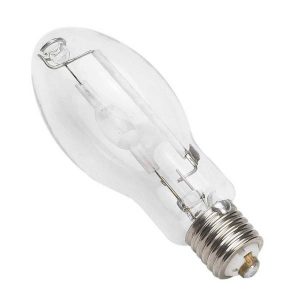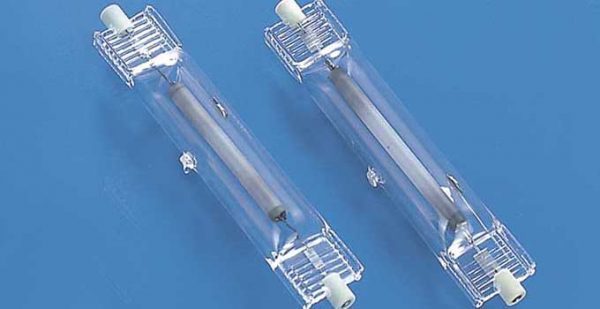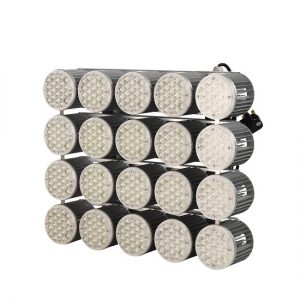Causes and Analysis of Failure of Ballasts for Metal Halide Lamps and High Pressure Sodium Lamps
Both high-pressure sodium lamps and metal halide lamps are negative resistance elements. Inductive ballasts are positive resistance elements. As long as the impedance of the ballast matches the bulb, the normal operating range of the bulb current can be guaranteed. Take a 1000W metal halide lamp as an example. According to the national standard, the ballast impedance is 18.5Ω, and the bulb tube pressure should be about 140V, so that the bulb can be stabilized in the working current range of about 7.5A.
If the bulb tube pressure is too low, only about 100V , The ballast will work above 180V, which is much higher than the working voltage of the ballast required by the 1000W metal halide lamp at 139V, or even above 180V. At this time, the output current of the ballast will reach above 10A, which will inevitably lead to When the ballast is working under high load, the result is that the ballast burns out and the bulb is also damaged. For this reason, the impedance of the bulb and the ballast must be matched.
The metal halide lamp products on the market are quite chaotic, and some of the poor bulbs have a tube voltage of only 80V-90V. Such a light bulb is equipped with the best ballast and cannot escape the fate of burnout.
In addition, the so-called American standard and European standard appear on the market. The parameters of the two standard metal halide lamps and ballasts are very different. European standard bulbs equipped with American standard ballasts will burn the ballast and bulbs. The American standard lamp is equipped with European standard ballast, which has low power and low brightness. Our national standard is based on the American standard, which is in line with international standards. The so-called European standard, in fact, there is no such standard in the world. There are two kinds of products in our country. Perhaps some European companies produce according to their own standards, and the so-called European standard appears.
Many companies in my country are imitations, that is, there are so-called European standard products. Many users are not clear about these two standards. They think that as long as a 1000W ballast can be equipped with a 1000W bulb, it is often the case that it is unavoidable to burn in actual use Bad things like this. Bulb manufacturers and ballast manufacturers, distributors and manufacturers complain about each other, in fact, they are caused by the confusion of the two standard products. Regardless of the standard, as long as users put forward corresponding requirements, we can provide users with satisfactory products.
As for burning terminals, this is mainly caused by poor contact. If the power leads of triggers, bulbs, and compensation capacitors are connected to the terminals, there will be contact resistance. Under high current working conditions for a long time, the contact resistance heats up and generates local high temperature, which causes the terminals and lead contacts to burn out. If the contact resistance reaches 0.5Ω or even greater, there will be a power loss of nearly 20W. The contact part is equivalent to a small electric furnace for a long time baking. Once the temperature exceeds the temperature resistance limit of the terminal, burning and burning will occur. Burning phenomenon, coupled with poor contact resulting in sparks and discharges, the current will be greater, which will accelerate the burning of the ballast terminals. This phenomenon is particularly prominent in high-power ballasts.
A large part of the ballast burning is caused by the power supply voltage being too high, which is much higher than the normal working conditions of the ballast. According to EU international standards, the normal working conditions of the ballast, the fluctuation range of the power supply voltage is allowed to be between +6% of 220V and -8% of 220V, that is, between 198V and 232V. In particular, please note that we are talking about the fluctuation range, not the working range. The so-called fluctuation is fluctuating in a short period of time. If you work under 232V voltage for a long time, it is generally considered that it will not exceed 2 hours. If it exceeds 2 hours, it is not fluctuation. But it works under high voltage, without special design, the ballast is easy to burn out.
In some countries in the world, the grid voltage is very unstable, the low is only 80~100V, and it can be as high as 120V~150V in the middle of the night or early morning. The ballast works on such a grid and is very easy to burn out. Therefore, we hope that the lighting circuit and power The lines are separated, and it is better to have voltage stabilization or automatic voltage regulation measures.
How to prevent the ballast from breaking
Based on the above analysis, to avoid burning the ballast and terminal, the following measures should be taken:
1. The impedance of the bulb and the ballast should match. For example: 1000W metal halide lamp tube pressure must reach about 130V.
- When connecting the wiring terminal, it must be connected reliably, and the lead wire diameter of the power supply and lamp cap shall not be less than 1.5mm.
- The manufacturer should consider making appropriate improvements to the material and wiring process of the terminal.
- It is recommended that bulbs, ballasts and triggers be supplied in the same company.
- The lighting circuit should be separated from the power circuit, and voltage stabilization or voltage regulation measures should be adopted.
What Is a High Pressure Sodium Lamp Ballast
In the working circuit of the high-pressure sodium lamp, the ballasts used with the bulb include inductive ballasts and electronic ballasts. The inductive ballast is made of an inductance coil and a silicon steel sheet loop in a non-closed shape, and a small gap is specially left to make the magnetic field in an unsaturated state, thereby stabilizing the current. Electronic ballast, as the name suggests, is a cathodic device composed of electronic components. It is also a product that has been implemented to save electricity in recent years. It has the characteristics of low power consumption, small size, light weight, high power factor, and instant start of bulbs; currently It is widely used in low-power gas discharge lamps (compact energy-saving lamps), while in high-power gas discharge lamps, it is more difficult.
Power consumption of high pressure sodium lamp ballast:
PFC = active power/actual power
The nominal power is generally the actual power under the rated voltage, and the actual power consumption is the nominal power*PFC value. The electronic ballast generally has a PFC value of 0.85 or more, and the inductive type is around 0.45. If it is inductive, the power grid The voltage change will also have an impact on the actual power consumption, and the PFC value ballast is marked.
Advantages and disadvantages of high pressure sodium lamp ballast
Advantage:
(1) Small size, light weight, mean time between failures up to 35000h,
(2) When the grid voltage fluctuates, the output power is guaranteed to be constant, and the light is stable and flicker-free to extend the bulb life by 20%.
(3) Using PFC correction technology, the current waveform is pure sine wave and has no effect on the power grid, realizing green lighting.
(4) The power factor (PFC) is as high as 0.99 or more, and the input current is half smaller than that of traditional inductive ballasts.
(5) The efficiency is above 94%, and the energy-saving effect is significantly above 10%.
(6) Wide operating voltage range, AC160V—264V, can work normally.
Disadvantage
Disadvantages of electronic ballasts for high pressure sodium lamps:
(1) Compared with inductive ballasts, electronic products have a higher failure rate.
(2) Since the product is relatively simple, there are more counterfeiters, so the quality is not uniform.
(3) Since there are many light source manufacturers, the parameters of the light source are not all the same, especially at the end of the life of the light source, the changes are relatively large, and the electronic ballast can be completely matched.
Precautions
Attention should be paid to the use of electronic ballasts for high-pressure sodium lamps:
Since the electronic ballast is composed of two to three hundred components, the following points should be noted:
(1) Handle with care,
(2) Pay attention to waterproof,
(3) Pay attention to high voltage when replacing; first switch off the power to change the bulb and then power on to check whether the bulb is damaged; if the new light does not light, then power off to replace the electronic ballast and then power on.
(4) When installing electronic ballasts, choose a location far away from the light source to avoid long-term operation at high temperatures.
(5) Do not use a multimeter or other instruments to test the output end of the electronic ballast to avoid high voltage damage to the instrument.
How to use high pressure sodium lamp under energy saving and optimized voltage
When designing the power supply line of urban street lights, in order to avoid line loss during the power transmission process, and the end voltage is too low during the peak power consumption, the street lights cannot be lighted. The output voltage of the street lamp transformer is generally higher than 5% of the rated value. The power grid voltage fluctuates, the power supply voltage of the street lamp is high and sometimes low, especially when the power consumption is low at midnight, the grid voltage will be higher, and the output voltage of the street lamp transformer will exceed 15% of the normal voltage, up to 240V.
For example, almost all the power of more than 30,000 street lamps in a city is connected from a public transformer. In order to ensure the voltage at the peak of electricity consumption, the output voltage of the public transformers are adjusted higher, so that when the electricity consumption trough in the second half of the night, the grid voltage rises, and some are as high as 240V or more. 85% of street lights in a certain area are powered by public transformers. According to local measurements in September 2009, the voltage of street lights was as high as 243V at 1-4 hours. The voltage in the middle of the night under the city street lights generally exceeds 230V, which will increase the power consumption by up to 22%. 
According to the test of high pressure sodium lamp arc extinguishing voltage test and national standard GB/T13259-2005 Appendix F: Measurement method of high pressure sodium lamp extinguishing voltage value, after the high pressure sodium lamp is normally ignited, the lamp voltage suddenly drops to 190V, even 180V, the high pressure sodium lamp will not Extinguished. Therefore, high-pressure sodium lamps can implement step-down power supply.
At present, the main method of reducing voltage and saving electricity of high pressure sodium lamps at home and abroad is to adopt electromagnetic lighting energy saver. For example, the GGDZ lighting voltage-stabilizing power-saving cabinet developed by Shanghai Panden has an average power saving rate of over 25%. A certain city installed 155 power-saving appliances with an installed capacity of 4666kVA in 2009. According to field tests by experts, the average power-saving rate reached 22.4%. At the end of January 20010, a street light center in a certain city installed 4 KTJSO series of new power savers in the urban area. These 4 power savers have a suspended box structure, which can save power by 20% to 40%. The NE device (ILUEST lighting stabilized dimmer) introduced from Spain has good energy-saving effects in some developed cities. NE is an energy-saving intelligent voltage regulating power supply device dedicated to gas discharge lamps. It is based on a multi-tap transformer as the core, equipped with an electronic controller and a regulated power supply device. According to the control command, the voltage can be automatically reduced to the energy-saving operating voltage. According to the actual measurement of 250W high pressure sodium lamp, when 200V power supply is used, it saves 20% power compared with 220V power supply.





